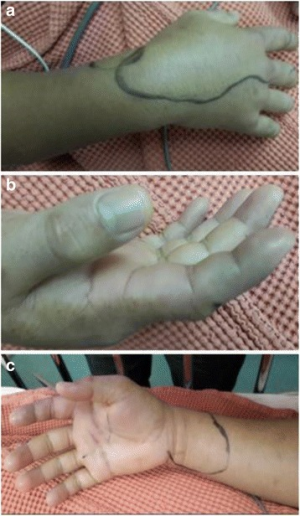The printable version is no longer supported and may have rendering errors. Please update your browser bookmarks and please use the default browser print function instead.
Background [1]
- Synanceia genus of fish of the family Synanceiidae
- Found in the coastal regions of the Indo-Pacific.
- This is a grey fish which possesses multiple venomous spines.
- The venom remains stable for up to 48 hours after the fish has died.
- This is the most venomous fish known, with venom likened to that of a cobra.
- The venom blocks cardiac calcium channels, increases systemic catecholamine release, simultaneously causing diffuse vasodilation and increased tissue destruction which propogates uptake of its own venom.
Clinical Features [2]

Extensive erythema, gross swelling up to the entire index finger, dorsum, and distal third forearm from stonefish envenomation.
- Local erythema, ecchymosis, swelling, necrosis
- Intense, sharp pain that peaks at 60 minutes but can lasts for days.
- Systemic toxicity:
- Death can occur in as few as 6 hours.
Differential Diagnosis
Evaluation
Workup
- No specific testing available
Diagnosis
Management [3]
- Pain management and venom neutralization is accomplished via hot-water (45 C) immersion for 30-60 minutes
- Clean wound, update tetanus, remove retained tissue
- One fifth of wounds develop local infection, but prophylactic antibiotics remain controversial [4]
- High risk for Vibrio vulnificus which can lead to necrotizing fasciitis.
- Antivenom includes Commonweatlth Serum Laboratories stonefish antivenom.
- All doses are intramuscular d/t risk of anaphylactoid reaction.
- Give 1 vial for 1-2 puncture wounds, 2 vials for 3-4 wounds, etc.
- 1 vial is equivalent to 2,000 units and neutralizes 20mg of venom
Disposition
- Patients should be observed for 6-12 hours.[5]
See Also
External Links
References
- ↑ Hauglid, C., Kiel, J., & Schmidt, A. (2021, April 23). Emergen-Sea Medicine: Overview of Marine Envenomations - Page 8 of 9. ACEP Now.https://www.acepnow.com/wp-content/uploads/2021/08/ACEP_August-2021.pdf
- ↑ Hauglid, C., Kiel, J., & Schmidt, A. (2021, April 23). Emergen-Sea Medicine: Overview of Marine Envenomations - Page 8 of 9. ACEP Now.https://www.acepnow.com/wp-content/uploads/2021/08/ACEP_August-2021.pdf
- ↑ Hauglid, C., Kiel, J., & Schmidt, A. (2021, April 23). Emergen-Sea Medicine: Overview of Marine Envenomations - Page 8 of 9. ACEP Now.https://www.acepnow.com/wp-content/uploads/2021/08/ACEP_August-2021.pdf
- ↑ *Hobday D, Chadha P, Din AH, Geh J. Denaturing the Lionfish. Eplasty. 2016 May 23;16:ic20. PMID: 27298709; PMCID: PMC4892334.
- ↑ Hauglid, C., Kiel, J., & Schmidt, A. (2021, April 23). Emergen-Sea Medicine: Overview of Marine Envenomations - Page 8 of 9. ACEP Now.https://www.acepnow.com/wp-content/uploads/2021/08/ACEP_August-2021.pdf




